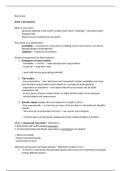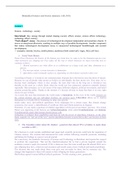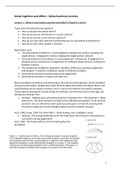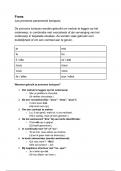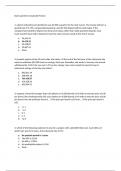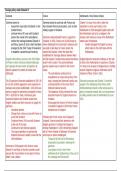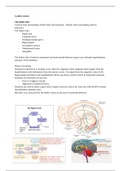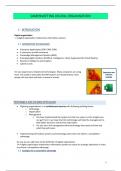Task 8 Epilepsy
What is epilepsy and how can you classify epilepsy?
Kolb, B. & Whishaw, I.Q. (2015). Fundamentals of Human Neuropsychology (7th Edition) & Lecture
& http://www.epilepsy.com (www)
Epilepsy – a neurological disease with unprovoked epileptic seizures. The
definition of epilepsy requires the occurrence of at least one epileptic seizure and
a recurrence risk for seizure is 60%. Seizures are not caused by some known
medical condition.
The disorder is often characterized by recurrent seizures associated with
a disturbance of consciousness and by its neurobiologic, cognitive,
psychological, and social consequences.
Seizure- spontaneous, abnormal discharges of brain neurons as a result of
scarring from injury, infections or tumors. Recurrent epileptic seizures of various
types that register on an EEG are associated with disturbances of consciousness.
1 person in 20 will experience at least one seizure in his or her lifetime.
Symptomatic seizures can be identified with a specific cause, such as
infection, trauma, tumor, vascular malformation, toxic chemicals, very
high fever, or other neurological disorder.
Idiopathic seizures appear to arise spontaneously and in the absence of
other CNS diseases.
Table 26.3 summarizes the great variety of circumstances that
appear to precipitate seizures. Although their range is striking, a
consistent feature is that the brain is most epileptogenic when it is
relatively inactive and the patient is still.
The most remarkable clinical feature of epileptic disorders is the widely varying
length of intervals between attacks—from minutes to hours to weeks or even
years. Describing a basic set of symptoms to be expected in all or even most
people with the disorder is almost impossible. At the same time, three particular symptoms occur in
many types of epilepsy:
1. Onset of an aura - An aura or warning is the first symptom of a seizure and is considered part
of the seizure. Often the aura is an indescribable feeling/ a subjective sensation. Other times
it’s easy to recognize and may be a change in feeling, sensation, thought, or behavior that is
similar each time a seizure occurs.
o Many people have no aura or warning; the seizure starts with a loss of consciousness
or awareness.
2. Loss of consciousness - ranging from complete collapse in some people to simply staring off
into space in others, and often accompanied by amnesia in which the victim forgets the
seizure itself and the period of lost consciousness.
3. Movement, as seizures commonly have a motor component, although the characteristics
vary considerably. Some people shake during an attack; others exhibit automatic
movements, such as rubbing the hands or chewing.
Seizure have a beginning, middle and end, but not all parts are visible or easy to separate. The
symptoms during a seizure are stereotypic (similar each time) and episodic (come and go).
Beginning (aura): Some people are aware of the beginning of a seizure, possibly as much as
hours or days before it happens. On the other hand, some people may not be aware of the
beginning and therefore have no warning.
1
, o Common symptoms before seizure: déjà vu, smells, sounds, visual loss or blurring,
lightheaded, tingling ....
Middle (the ictal phase): the period of time from the first symptoms (including an aura) to
the end of the seizure activity. This correlates with the electrical seizure activity in the brain.
Sometimes the visible symptoms last longer than the seizure activity on an EEG. This is
because some of the visible symptoms may be after effects of a seizure or not related to
seizure activity at all.
o Common symptoms during seizure: loss of awareness, confused, distracted/
daydreaming, unable to hear, flashing lights, blurry vision, difficulty talking, unable to
swallow/drooling , tremors, rigid or tense muscles....
Ending (the postictal phase): recovery period after seizure. Some people recover
immediately while others may take minutes to hours to feel like their usual self. The type of
seizure, as well as what part of the brain the seizure impacts, affects the recovery period.
o Common symptoms after a seizure: not be able to respond right away, confused,
memory loss, nausea, thirsty, may feel tired....
Typically, EEG confirms the diagnosis of epilepsy. In some people with epilepsy, however, seizures
are difficult to demonstrate in this way except under special circumstances (when challenged by a
flashing light, for example, or in an EEG recorded during sleep). Moreover, not all people with an EEG
suggestive of epilepsy actually have seizures. Some estimates suggest that one person in five has an
abnormal EEG pattern—far more than the number of people thought to have epilepsy.
Classifying seizures & brain areas
Consider 3 things when describing seizures; 1)the onset or beginning of a seizure; 2) a person’s level
of awareness during a seizure and 3) whether movements happen during a seizure.
Generalized seizures – are bilaterally symmetrical (affect both sides of the brain or groups of
cells on both sides of the brain at the same time), without a focal onset, occur in widespread
regions of the brain.
o Symptoms:
Motor symptoms: clonic (sustained, repetitive rhythmical jerking
movements); atonic (muscles becoming weak or limp), tonic (muscles
becoming tense or rigid), myoclonus (brief muscle twitching), or epileptic
spasms (body flexes and extends repeatedly).
Non- motor symptoms: usually called absence seizures. Absence seizures can
also have brief twitches (myoclonus) that can affect a specific part of the
body or just the eyelids.
o About 50% are preceded by an aura
2
What is epilepsy and how can you classify epilepsy?
Kolb, B. & Whishaw, I.Q. (2015). Fundamentals of Human Neuropsychology (7th Edition) & Lecture
& http://www.epilepsy.com (www)
Epilepsy – a neurological disease with unprovoked epileptic seizures. The
definition of epilepsy requires the occurrence of at least one epileptic seizure and
a recurrence risk for seizure is 60%. Seizures are not caused by some known
medical condition.
The disorder is often characterized by recurrent seizures associated with
a disturbance of consciousness and by its neurobiologic, cognitive,
psychological, and social consequences.
Seizure- spontaneous, abnormal discharges of brain neurons as a result of
scarring from injury, infections or tumors. Recurrent epileptic seizures of various
types that register on an EEG are associated with disturbances of consciousness.
1 person in 20 will experience at least one seizure in his or her lifetime.
Symptomatic seizures can be identified with a specific cause, such as
infection, trauma, tumor, vascular malformation, toxic chemicals, very
high fever, or other neurological disorder.
Idiopathic seizures appear to arise spontaneously and in the absence of
other CNS diseases.
Table 26.3 summarizes the great variety of circumstances that
appear to precipitate seizures. Although their range is striking, a
consistent feature is that the brain is most epileptogenic when it is
relatively inactive and the patient is still.
The most remarkable clinical feature of epileptic disorders is the widely varying
length of intervals between attacks—from minutes to hours to weeks or even
years. Describing a basic set of symptoms to be expected in all or even most
people with the disorder is almost impossible. At the same time, three particular symptoms occur in
many types of epilepsy:
1. Onset of an aura - An aura or warning is the first symptom of a seizure and is considered part
of the seizure. Often the aura is an indescribable feeling/ a subjective sensation. Other times
it’s easy to recognize and may be a change in feeling, sensation, thought, or behavior that is
similar each time a seizure occurs.
o Many people have no aura or warning; the seizure starts with a loss of consciousness
or awareness.
2. Loss of consciousness - ranging from complete collapse in some people to simply staring off
into space in others, and often accompanied by amnesia in which the victim forgets the
seizure itself and the period of lost consciousness.
3. Movement, as seizures commonly have a motor component, although the characteristics
vary considerably. Some people shake during an attack; others exhibit automatic
movements, such as rubbing the hands or chewing.
Seizure have a beginning, middle and end, but not all parts are visible or easy to separate. The
symptoms during a seizure are stereotypic (similar each time) and episodic (come and go).
Beginning (aura): Some people are aware of the beginning of a seizure, possibly as much as
hours or days before it happens. On the other hand, some people may not be aware of the
beginning and therefore have no warning.
1
, o Common symptoms before seizure: déjà vu, smells, sounds, visual loss or blurring,
lightheaded, tingling ....
Middle (the ictal phase): the period of time from the first symptoms (including an aura) to
the end of the seizure activity. This correlates with the electrical seizure activity in the brain.
Sometimes the visible symptoms last longer than the seizure activity on an EEG. This is
because some of the visible symptoms may be after effects of a seizure or not related to
seizure activity at all.
o Common symptoms during seizure: loss of awareness, confused, distracted/
daydreaming, unable to hear, flashing lights, blurry vision, difficulty talking, unable to
swallow/drooling , tremors, rigid or tense muscles....
Ending (the postictal phase): recovery period after seizure. Some people recover
immediately while others may take minutes to hours to feel like their usual self. The type of
seizure, as well as what part of the brain the seizure impacts, affects the recovery period.
o Common symptoms after a seizure: not be able to respond right away, confused,
memory loss, nausea, thirsty, may feel tired....
Typically, EEG confirms the diagnosis of epilepsy. In some people with epilepsy, however, seizures
are difficult to demonstrate in this way except under special circumstances (when challenged by a
flashing light, for example, or in an EEG recorded during sleep). Moreover, not all people with an EEG
suggestive of epilepsy actually have seizures. Some estimates suggest that one person in five has an
abnormal EEG pattern—far more than the number of people thought to have epilepsy.
Classifying seizures & brain areas
Consider 3 things when describing seizures; 1)the onset or beginning of a seizure; 2) a person’s level
of awareness during a seizure and 3) whether movements happen during a seizure.
Generalized seizures – are bilaterally symmetrical (affect both sides of the brain or groups of
cells on both sides of the brain at the same time), without a focal onset, occur in widespread
regions of the brain.
o Symptoms:
Motor symptoms: clonic (sustained, repetitive rhythmical jerking
movements); atonic (muscles becoming weak or limp), tonic (muscles
becoming tense or rigid), myoclonus (brief muscle twitching), or epileptic
spasms (body flexes and extends repeatedly).
Non- motor symptoms: usually called absence seizures. Absence seizures can
also have brief twitches (myoclonus) that can affect a specific part of the
body or just the eyelids.
o About 50% are preceded by an aura
2

